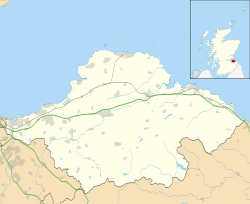Inveresk Roman Fort facts for kids
Quick facts for kids Inveresk Roman Fort |
|
|---|---|

Inveresk Parish Kirk, site of the Roman Fort
|
|
| Structure | |
| — Stone? structure — | |
| Size and area | (2.7 ha) |
| Location | |
| Coordinates | 55°56′11″N 3°03′17″W / 55.9365°N 3.0546°W |
| Place name | Inveresk |
| County | East Lothian |
| Country | Scotland |
| Reference | |
| UK-OSNG reference | NT345722 |
Inveresk Roman Fort is an archaeological site within the grounds of St Michael's Church, Inveresk, a village in East Lothian, Scotland. Several seasons of excavation since 1946, both major and minor, have established the outline of the fort and recovered some of the interior detail.
The fort covered an area of 6.6 acres (2.7 ha), placing it at the larger end of the spectrum of fort sizes. For this reason, the original excavator, Ian Richmond, believed that a cavalry regiment had been stationed here. Little is known of the interior buildings, so this hypothesis cannot yet be tested. In 2007 a Roman tombstone was found at nearby Carberry depicting a Roman Governor's guard cavalry trooper named "Crescens" who was perhaps residing at the fort when he died.
All of the datable artefacts point to Antonine occupation. Consequently, the fort is thought to have been established in the immediate aftermath of the invasion of Scotland launched by the emperor Antoninus Pius in AD 139/140. Two clear phases of occupation were identified archaeologically, perhaps occasioned by a change of garrison during the Antonine period. The fort will have been abandoned, along with the other Scottish sites, around AD 160, when Hadrian's Wall was recommissioned.
A substantial civil settlement (vicus) lay outside the east rampart of the fort, and included a curving structure thought to be an amphitheatre.
The fort's Roman name remains unknown, although it has been suggested that Ptolemy's Κούρια (Curia or Coria), located in the lands of the Votadini, should be identified with Inveresk, "the name being transferred from a native meeting-place which it controlled (in this case perhaps Arthur's Seat, 4 miles to the west)". It may also have been called "Evidensca" according to the Ravenna Cosmography.



